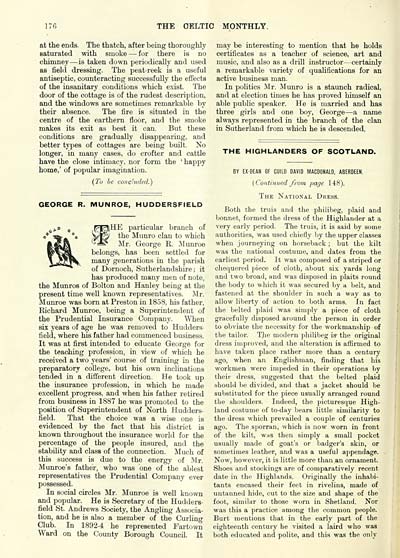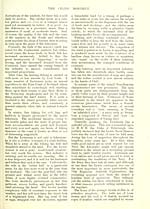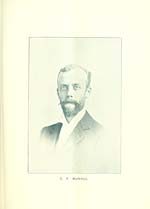Blair Collection > Celtic monthly > Volume 5, 1897
(250)
Download files
Complete book:
Individual page:
Thumbnail gallery: Grid view | List view

176
THE CELTIC MONTHLY.
at the ends. The thatch, after being thoroughly
saturated with smoke — for there is no
chimney — is taken down periodically and used
as field dressing. The peat-reek is a useful
antiseptic, counteracting successfully the effects
of the insanitary conditions which exist. The
door of the cottage is of the rudest description,
and the windows are sometimes remarkable by
their absence. The fire is situated in the
centre of the earthern floor, and the smoke
makes its exit as best it can. But these
conditions are gradually disappearing, and
better types of cottages are being built. No
longer, in many cases, do crofter and cattle
have the close intimacy, nor form the ' happy
home,' of popular imagination.
(2o be concluded.)
GEORGE R. MUNROE, HUDDERSFIELD
|p|ra|HE particular branch of
W^ the Munro clan to which
*j;** Mr. George R. Munroe
belongs, has been settled for
many generations in the parish
of Dornoch, SutherlandshLre ; it
has produced many men of note,
the Munros of Bolton and Hanley being at the
present time well known representatives. Mr.
Munroe was born at Preston in 1858, his father,
Richard Munroe, being a Superintendent of
the Prudential Insurance Company. When
six years of age he was removed to Hudders-
tield, where his father had commenced business.
It was at first intended to educate George for
the teaching profession, in view of which he
received a two years' course of training hi the
preparatory college, but his own inclinations
tended in a different direction. He took up
the insurance profession, in which he made
excellent progress, and when his father retired
from business in 1887 he was promoted to the
position of Superintendent of North Hudders-
field. That the choice was a wise one is
evidenced by the fact that his district is
known throughout the insurance world for the
percentage of the people insured, and the
stability and class of the connection. Much of
this success is due to the energy of Mr.
Munroe's father, who was one of the ablest
representatives the Prudential Company ever
In social circles Mr. Munroe is well known
and popular. He is Secretary of the Hudders-
field St. Andrews Society, the Angling Associa-
tion, and he is also a member of the Curling
Club. In 18924 he represented rart(wn
Ward on the County Borough Council. It
may be interesting to mention that he holds
certificates as a teacher of science, art and
music, and also as a drill instructor — certainly
a remarkable variety of qualifications for an
active business man.
In politics Mr. Munro is a staunch radical,
and at election times he has proved himself an
able public speaker. He is married and has
three girls and one boy, George — a name
always represented in the branch of the clan
in Sutherland from which he is descended.
THE HIGHLANDERS OF SCOTLAND.
BY EX-DEAN OF GUILD DAVID MACDONALD, ABERDEEN.
(Continued from page 148).
The National Dress.
Both the truis and the philibeg, plaid and
bonnet, formed the dress of the Highlander at a
very early period. The truis, it is said by some
authorities, was used chiefly by the upper classes
when Journeying on horseback ; but the kilt
was the national costume, and dates from the
earliest period. It was composed of a striped or
chequered piece of cloth, about six yards long
and two broad, and was disposed in plaits round
the body to which it was .secured by a belt, and
fastened at the shoulder in such a way as to
allow liberty of action to both arms. In fact
the belted plaid was simply a piece of cloth
gracefully disposed around the person in order
to obviate the necessity for the workmanship of
the tailor. The modern philibeg is- the original
dress improved, and the alteration is affirmed to
have taken place rather more than a century
ago, when an Englishman, finding that his
workmen were impeded in their operations by
their dress, suggested that the belted plaid
should be divided, and that a jacket should be
substituted for the piece usually arranged round
tlie shoulders. Indeed, the picturesque High-
land costume of to-day bears little similarity to
the dress which prevailed a couple of centuries
ago. The sporran, which is now worn in front
of the kilt, Wils then simply a small pocket
usually made of goat's or badger's skin, or
sometimes leather, and was a useful appendage.
Now, however, it is little more than an ornament.
Shoes and stockings are of comparatively recent
date in the Highlands. Originally the inhabi-
tants encased their feet in rivelins, made of
untanned hide, cut to the size and shape of the
foot, similar to those worn in Shetland. Nor
was this a practice among the common people.
Burt mentions that in the early part of the
eighteenth century he visited a laird who was
both educated and polite, and this was the only
THE CELTIC MONTHLY.
at the ends. The thatch, after being thoroughly
saturated with smoke — for there is no
chimney — is taken down periodically and used
as field dressing. The peat-reek is a useful
antiseptic, counteracting successfully the effects
of the insanitary conditions which exist. The
door of the cottage is of the rudest description,
and the windows are sometimes remarkable by
their absence. The fire is situated in the
centre of the earthern floor, and the smoke
makes its exit as best it can. But these
conditions are gradually disappearing, and
better types of cottages are being built. No
longer, in many cases, do crofter and cattle
have the close intimacy, nor form the ' happy
home,' of popular imagination.
(2o be concluded.)
GEORGE R. MUNROE, HUDDERSFIELD
|p|ra|HE particular branch of
W^ the Munro clan to which
*j;** Mr. George R. Munroe
belongs, has been settled for
many generations in the parish
of Dornoch, SutherlandshLre ; it
has produced many men of note,
the Munros of Bolton and Hanley being at the
present time well known representatives. Mr.
Munroe was born at Preston in 1858, his father,
Richard Munroe, being a Superintendent of
the Prudential Insurance Company. When
six years of age he was removed to Hudders-
tield, where his father had commenced business.
It was at first intended to educate George for
the teaching profession, in view of which he
received a two years' course of training hi the
preparatory college, but his own inclinations
tended in a different direction. He took up
the insurance profession, in which he made
excellent progress, and when his father retired
from business in 1887 he was promoted to the
position of Superintendent of North Hudders-
field. That the choice was a wise one is
evidenced by the fact that his district is
known throughout the insurance world for the
percentage of the people insured, and the
stability and class of the connection. Much of
this success is due to the energy of Mr.
Munroe's father, who was one of the ablest
representatives the Prudential Company ever
In social circles Mr. Munroe is well known
and popular. He is Secretary of the Hudders-
field St. Andrews Society, the Angling Associa-
tion, and he is also a member of the Curling
Club. In 18924 he represented rart(wn
Ward on the County Borough Council. It
may be interesting to mention that he holds
certificates as a teacher of science, art and
music, and also as a drill instructor — certainly
a remarkable variety of qualifications for an
active business man.
In politics Mr. Munro is a staunch radical,
and at election times he has proved himself an
able public speaker. He is married and has
three girls and one boy, George — a name
always represented in the branch of the clan
in Sutherland from which he is descended.
THE HIGHLANDERS OF SCOTLAND.
BY EX-DEAN OF GUILD DAVID MACDONALD, ABERDEEN.
(Continued from page 148).
The National Dress.
Both the truis and the philibeg, plaid and
bonnet, formed the dress of the Highlander at a
very early period. The truis, it is said by some
authorities, was used chiefly by the upper classes
when Journeying on horseback ; but the kilt
was the national costume, and dates from the
earliest period. It was composed of a striped or
chequered piece of cloth, about six yards long
and two broad, and was disposed in plaits round
the body to which it was .secured by a belt, and
fastened at the shoulder in such a way as to
allow liberty of action to both arms. In fact
the belted plaid was simply a piece of cloth
gracefully disposed around the person in order
to obviate the necessity for the workmanship of
the tailor. The modern philibeg is- the original
dress improved, and the alteration is affirmed to
have taken place rather more than a century
ago, when an Englishman, finding that his
workmen were impeded in their operations by
their dress, suggested that the belted plaid
should be divided, and that a jacket should be
substituted for the piece usually arranged round
tlie shoulders. Indeed, the picturesque High-
land costume of to-day bears little similarity to
the dress which prevailed a couple of centuries
ago. The sporran, which is now worn in front
of the kilt, Wils then simply a small pocket
usually made of goat's or badger's skin, or
sometimes leather, and was a useful appendage.
Now, however, it is little more than an ornament.
Shoes and stockings are of comparatively recent
date in the Highlands. Originally the inhabi-
tants encased their feet in rivelins, made of
untanned hide, cut to the size and shape of the
foot, similar to those worn in Shetland. Nor
was this a practice among the common people.
Burt mentions that in the early part of the
eighteenth century he visited a laird who was
both educated and polite, and this was the only
Set display mode to: Large image | Transcription
Images and transcriptions on this page, including medium image downloads, may be used under the Creative Commons Attribution 4.0 International Licence unless otherwise stated. ![]()
| Early Gaelic Book Collections > Blair Collection > Celtic monthly > Volume 5, 1897 > (250) |
|---|
| Permanent URL | https://digital.nls.uk/75853744 |
|---|
| Shelfmark | Blair.57 |
|---|---|
| Additional NLS resources: | |
| Attribution and copyright: |
|
| Description | A selection of books from a collection of more than 500 titles, mostly on religious and literary topics. Also includes some material dealing with other Celtic languages and societies. Collection created towards the end of the 19th century by Lady Evelyn Stewart Murray. |
|---|
| Description | Selected items from five 'Special and Named Printed Collections'. Includes books in Gaelic and other Celtic languages, works about the Gaels, their languages, literature, culture and history. |
|---|

